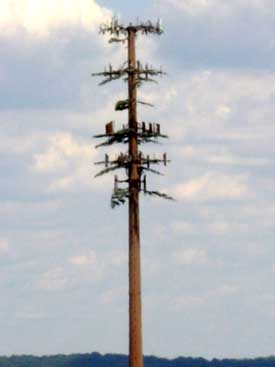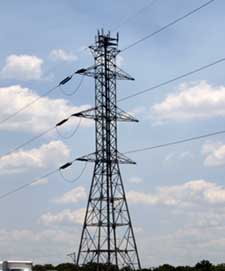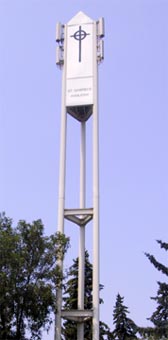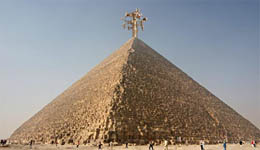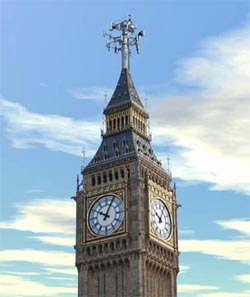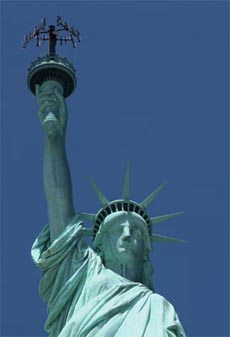pop up description layer
HOME
Cryptozoology UFO Mysteries Aviation Space & Time Dinosaurs Geology Archaeology Exploration 7 Wonders Surprising Science Troubled History Library Laboratory Attic Theater Store Index/Site Map Cyclorama
Search the Site: |
|
Cellular Deception The cell phone has conquered our society. Now it's going after our foliage. (08/08) The other day I was driving down the Pennsylvania Turnpike when something caught my eye. On the right side of the road was a tree. Now we have plenty of trees in Pennsylvania, so this in itself was not particularly significant. What caught my attention about the tree was its esthetics: It had none. It was the homeliest, butt-ugliest tree in existence. Now there are some nature lovers who believe no tree can be truly ugly. But with apologies to Joyce Kilmer (that's the man who wrote the verse that starts "I think I shall never see a poem lovely as a tree…") this tree was truly an offense to nature. Kilmer had obviously never observed this particular species of gymnosperm. It shot up to perhaps a hundred feet in height with a perfectly straight trunk and only the last twenty feet or so at the top had foliage. The horrid thing was apparently some sort of evergreen and those last few feet formed a strangely perfect - almost stereotypical perfect - cone shape.
As I drew closer to the hideous thing I realized that Kilmer was right after all. His rhyme ends with "Poems are made by fools like me, But only God can make a tree." Indeed this monstrosity was not created by God, but by man. It wasn't really a tree, but a cell antenna tower in disguise. The Rise of the Cellular Culture Cell phones are ubiquitous in the United States and common place throughout most of the rest of the world. The number of cell phones on our planet moved past the 1 billion mark in 2002. The most recent figures I've seen show the number of subscribers in the United States alone at about 300 million. Since the phones and other related devices like PDAs are small with tiny batteries, their ability to transmit signals any distance is severely limited. Typically, if your cell phone isn't within three miles of a tower, it won't work. Areas with lots of hills that interfere with radio waves may require even closer distances. As more and more cell phones and other devices (like PDAs and pagers) that use the cell network come on line, the number of cell towers around us will continue to increase.
This hasn't caused much of a problem in big cities where a few more antennas sprouting from big buildings are hardly noticeable. Originally even in suburban and rural locations where towers wereplaced out of sight in industrial parks there wasn't a problem either. These locations were fine when most people just used the phones to communicate while driving along the highway. As cell phone usage has moved into the home and started replacing "land lines" (with the help of all those teenagers sitting in their rooms and texting their friends) cell phone companies have found it necessary to put towers in the heart of residential areas. Many of those living in the surrounding houses, however, have found the towers esthetically displeasing and have moved to limit their numbers. This means that companies that want to build cell towers have found increasing community opposition to new installations. In some cases they have been lucky enough to be able to simply locate their cell equipment onto an existing tower. For example, a power line tower can also carry cell antennas. Where there are no existing usable towers or structures available, however, companies have been forced to find other ways to erect their antennas while appeasing nearby residents.
Disguising the Eyesores This had led to a whole side industry that makes money by disguising cell phone towers either by making them blend into the landscape or giving them an alternate identity. Larson Utility Camouflage of Tucson, Arizona, is one of the largest companies that does this. They can hide the towers as trees, flagpoles and even as saquaro cacti (that's the type of cactus you seen in old westerns that sport the arms). In addition, the company can also create fake man-made buildings to hide the antennas. In rural Illinois amidst rolling farm fields, Larson disguised one tower as a fake grain silo. In southern California the company built a fake rustic water tower to contain antennas (apparently an old water tower is considered more picturesque than a modern cell tower). To hide an installation on an existing west coast building they also constructed a fake chimney. Probably my favorite disguised cell tower is masquerading as a lighthouse. It looks very nice, though the fact that it is located twenty miles from any major body of water is a dead giveaway that the structure is not exactly what it seems to be. Windfall for Churches
Churches have become unexpected allies to the phone companies. Many older cathedrals and chapels have high steeples or bell towers which make perfect platforms for cellular antennas. The antennas just need to be hidden inside. Churches also have the advantage of often being located in residential sections of the city, just the area where the tower builders find the most resistance to building new structures, but need more coverage. Most churches are happy to let their steeples be wired up as they get a significant lease fee for letting the phone company use the space. Even if a church has no steeple, they can still benefit. Tower builders will go as far as adding a steeple to an existing building or creating a freestanding bell tower, or even a giant cross as long as they can load it with cell equipment. Neighbors are not always happy when the church across the street decides to put up a hundred foot-high cross on their property. However, because of the traditional constitutional protection of religion in the United States, churches have more freedom to push the zoning codes than a business would. This raises an interesting ethical question: Should you erect a new cross or steeple over your neighbors objections, if you are doing it less for religious convictions, and more from the revenue from the cell antennas contained inside it?
Neighborhood schools are also finding they can make a profit from the cellular business. Schools, like churches, are often located in residential neighborhoods making them prime locations for antennas. School districts almost invariably need money and the leasing fees can buy a lot of extra books or fund new uniforms for the marching band. Health Concerns Mounting cell phone towers on top of schools, though, makes some people nervous. Several groups have claimed that the electromagnetic radiation from cell tower antennas can increase the risk of cancer. However, no reputable study has ever established a relationship between cell towers and cancer and there is no known scientific mechanism that could produce such cancer. A more likely source of trouble is the signals coming directly from cell phones. These are weaker that those coming from a tower, but given cell phones are usually held directly up against the operator's head within inches of the brain, they would be a better candidate for a public health problem. Again, there is no known scientific mechanism for suggest this is dangerous, but a study recently found a possible connection between long term (ten years) cell phone use and certain types of rare brain tumors. Many other studies have failed to show such a link, and the subject is still being hotly debated. More studies are sure to follow.
With no proof of health issues, communities can't legally keep cell towers out, though they have managed in many cases to insist that they be hidden. But are these, somewhat inept deceptions (like my ugly tree) worth it? Now I don't think that I'm a Ludite. I'm not anti-cell phone. Not even anti-cell phone tower. Some of the disguises blend in so well to the surrounding area that people don't even realize they are there. What concerns me is badly disguised cell phone towers and antenna that, in my opinion, look worse than just a regular tower. Usually man-made structures that hide cell towers appear to be fairly effective. Most often it's when they try and mimic a natural object, like tree, that things get ugly. In fact, I will even go so far as to say that some of the trees look good if they are grouped with real trees of the same size and type - the palms with their long, branchless straight trunks and cluster of foliage at the very top seem to work well. It's the solitary one hundred foot tall pine with a handful of branches at the top sitting in the middle of a farm field that looks ridiculous. To paraphrase Kilmer, "I think that I shall never see, a cell phone tower lovely as a tree…"
Copyright Lee Krystek, 2008. All Rights Reserved. |
|
Related Links |
|
|



